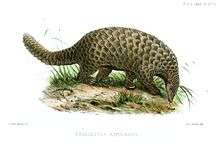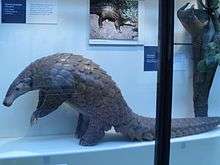Giant pangolin
| Giant pangolin[1] | |
|---|---|
| | |
| Scientific classification | |
| Kingdom: | Animalia |
| Phylum: | Chordata |
| Class: | Mammalia |
| Order: | Pholidota |
| Family: | Manidae |
| Genus: | Smutsia |
| Species: | S. gigantea |
| Binomial name | |
| Smutsia gigantea [3] (Illiger, 1815) | |
 | |
| Giant pangolin range | |
| Synonyms | |
| |
The giant pangolin (Smutsia gigantea) is a pangolin species. Members of the species inhabit Africa with a range stretching along the equator from West Africa to Uganda. The giant pangolin is the largest species of pangolins, or "scaly anteaters" – the large, scaled mammals belonging to the family Manidae. It subsists almost entirely on ants and termites. The species was first described by Johann Karl Wilhelm Illiger in 1815.
Description
The giant pangolin is the largest of all pangolin species. While its average mass has not been measured, one specimen was found to weigh 33 kg (72.6 lb). Males are larger than females, with male body lengths about 140 cm (4.6 ft) and females about 125 cm (4.1 ft). Like all pangolins, the species is armored with large, brown to reddish-brown scales formed from keratin. Curiously, it also has eyelashes. The giant pangolin has a long snout, a long, thick tail, and large front claws.
The animal has a strong sense of smell and large anal glands. Its secretions may be significant to animal communication. The species walks with most of its weight is on its columnar rear legs, and curls its front paws, walking on the outside of the wrists rather than the palms to protect the claws. By using its tail for balance, it often walks upright as a biped.
Distribution and habitat

The giant pangolin inhabits many countries, with the largest concentration in Uganda, Tanzania, and western Kenya. It is found mainly in the savanna, rainforest, and forest, inhabiting areas with large termite populations and available water. It does not inhabit high-altitude areas.
Behavior

The giant pangolin, like other pangolins, is nocturnal, which makes observation difficult. It is also usually solitary, although in one case an adult was seen in a burrow with a juvenile. The species is capable of climbing trees and other objects.
Diet
Like all pangolins, the giant pangolin is a specialized insectivore that lacks teeth and the ability to chew. Its diet mainly consists of ants and termites, which it finds by tearing open anthills and termite nests, both subterranean and mound-type.
Because of its relatively large size, the giant pangolin is particularly well-suited to breaking open termite mounds by leaning on the mound and resting its weight on its tail, and then ripping into the mound with its front claws. The combination of weight and physical damage quickly leads to a partial collapse of the mound, exposing the termites. Only the adults are strong enough to do this; their young must follow behind their mothers until they grow large enough to do it for themselves. It eats the insects by picking them up with its sticky tongue, which is up to 16 in (41 cm) long.
Reproduction
Very little information about the reproduction of the giant pangolin is known. Two birth records exist, with one litter in September and another in October, with the young weighing around 500 g (18 oz). As in all pangolins, infants have soft scales that eventually harden, and are born with open eyes. They cannot walk on their legs, but can move on their bellies. During age 6–8 weeks, the young often spew a yellow secretion from their anal glands(that is often said to smell of decay and cabbage) to keep predators and other animals from taking advantage of their mothers.
Conservation
Due to habitat destruction and deforestation, the species is in great decline, and this, together with hunting of it as bushmeat and for the supposed medicinal properties of its scales, has led to concerns about population levels. The scale of the problem has recently been highlighted by the Traffic conservation programme.[4] Because the species is nocturnal, few studies have been carried out. Currently, this pangolin is classified as vulnerable by the IUCN.[2]
References
- ↑ Schlitter, D.A. (2005). "Order Pholidota". In Wilson, D.E.; Reeder, D.M. Mammal Species of the World: A Taxonomic and Geographic Reference (3rd ed.). Johns Hopkins University Press. p. 530. ISBN 978-0-8018-8221-0. OCLC 62265494.
- 1 2 Waterman, C.; Pietersen, D.; Hywood, L.; Rankin, P. & Soewu, D. (2014). "Smutsia gigantea". IUCN Red List of Threatened Species. Version 2014.2. International Union for Conservation of Nature. Retrieved 2014-07-29.
- ↑ Gaudin, Timothy (28 August 2009). "The Phylogeny of Living and Extinct Pangolins (Mammalia, Pholidota) and Associated Taxa: A Morphology Based Analysis" (PDF). Journal of Mammalian Evolution. 16 (4): 235–305. doi:10.1007/s10914-009-9119-9. Retrieved 14 May 2015.
- ↑ "The trade of African pangolins to Asia: a brief case study of pangolin shipments from Nigeria" (PDF). Traffic Bulletin. 28 (1). 2016.
Further reading
- Ciszek, Deborah. "Manis gigantea (giant pangolin)." Animal Diversity Web, University of Michigan Museum of Zoology. June 1999.
- "Pangolin." African Wildlife Foundation.
External links
| Wikispecies has information related to: Smutsia gigantea |
